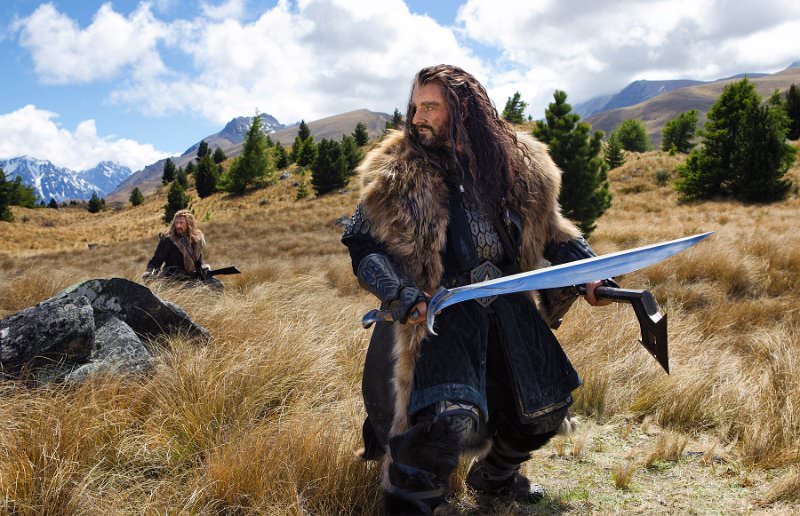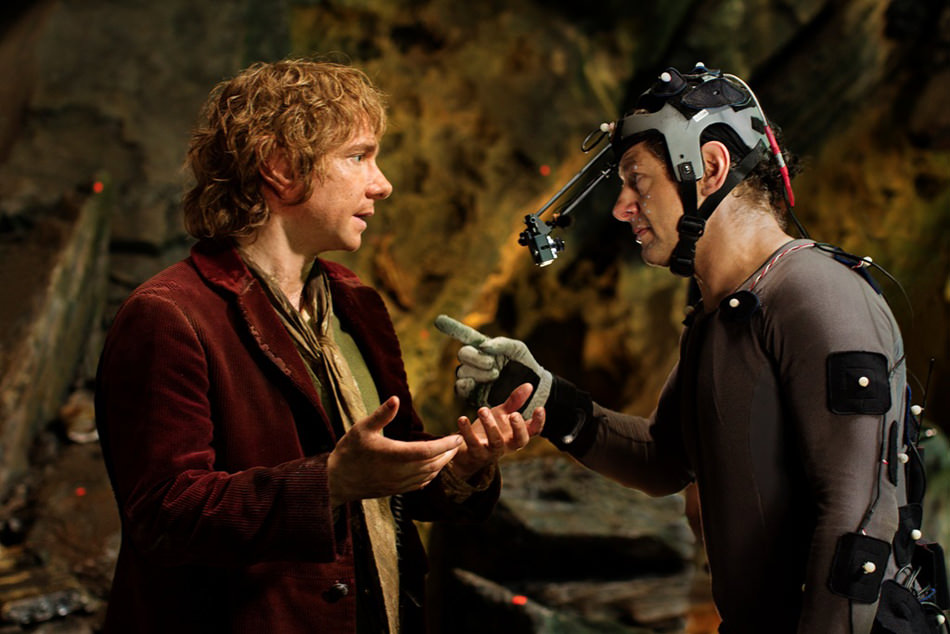There is a good deal to be said about Peter Jackson’s long-awaited and exceedingly long adaptation of J.R.R. Tolkien’s The Hobbit, most of it bad.
I speak as a former, if long-lapsed, member of the Tolkien cult—one who vividly recalls a 12-year-old’s impassioned assertion that he had the right to borrow books, namely The Lord of the Rings, from the library’s Adult Section, who searched in vain for anything even remotely comparable (C.S. Lewis was grade-school stuff, Robert E. Howard seemed lame), who, a few years later, saved up and sent away to a London bookstore to purchase his own hardbound copies of the trilogy, and who was soon after shocked to see the books appear here as garish, unauthorized Ace paperbacks.
Of course, the first thing to note is that this movie, which is officially called The Hobbit: An Unexpected Journey and is the first of three (more) epic features that will be extracted from Tolkien’s modest, charming preamble to The Lord of the Rings trilogy, is impervious to criticism—or perhaps too big to fail. For many, a chance to return to the Jackson-Tolkien world, this time in 3D, will trump all caveats and already has. The Hobbit grossed nearly $85 million last weekend (a new record for a December opening) and is predicted to take in as much as a half billion before New Year’s in North America alone.
A day after the film opened, The Wall Street Journal reported the brisk current trade in Hobbit first editions, Lord of the Rings movie props, prop replicas, and an assortment of limited edition collectibles, including an eighteen-carat solid gold Ring of Power that sells for $3300. Jackson’s native New Zealand, where The Hobbit—like the Ring trilogy—was shot, has merged with Middle Earth. Not only was the New Zealand army deployed to build access roads to Jackson’s set but, anticipating a flood of tourists, the nation has been transformed into a Tolkien theme-park. The Prime Minister is photographed brandishing a wood and silver replica of Frodo’s sword, a giant Gollum is suspended from the ceiling of the Wellington Airport, and an excited newsreader celebrated The Hobbit’s premiere by delivering the weather report in Elvish.
Although lacking the visionary chutzpah and demented social energy that characterized the great pulp fantasies orchestrated by Fritz Lang in the 1920s, Jackson’s Ring trilogy was the greatest feat of pop movie magic between Titanic and Avatar. Not so The Hobbit which, less a movie than a promotion for its inevitable ancillary computer game, features endless digital battles predicated on space-warping virtual camera moves and chute-and-ladder sudden escapes. Reviewing the Ring trilogy in the mid 1950s, Edmund Wilson famously called it “a children’s book which has somehow got out of hand.” The same could be said of The Hobbit. In this case, a children’s story got out of hand and morphed into Battlefield 3.
Heavily dependent on computer-generated imagery, The Hobbit has also been ballyhooed for introducing a new technology. Projected at forty-eight frames per second rather than the usual twenty-four, Jackson’s movie bombards the retina with twice the visual information of a standard film. Does it matter? It does seem as though this innovation has solved the problem of the dark polaroid glasses needed for stereo visions. The 3D struck me as brighter, if disconcertingly sharp. Others have described the image quality as thin or shiny. (The critic Dave Kehr called it “a heightened video look.”) In any case, this improvement was overwhelmed by the repetitive violence of the digital carnage and the ugliness of the CGI.
The technology is sophisticated; the realization is coarse. The hobbit-home known as the Shire seems landscaped to resemble a miniature golf course. The dwarfs who take hobbit Bilbo on a quest look like a collection of Toby Jugs; their Kingdom under the Mountain that they hope to retake is Donald Trump’s idea of Ali Baba’s cave. The trolls might have been designed by Jack Kirby in his Atlas comic book phase, although the Battle of the Stone Giants did evoke Dali’s Soft Construction with Boiled Beans.
Throughout The Hobbit, I found myself watching for those shots that were not in some way digitally sweetened (these were mainly close-ups—the fish fillet on Bilbo’s dinner plate, the patented radiance of Cate Blanchett’s smile) and wondering what percentage of CGI is necessary for a movie to be considered graphic rather than photographic. Hoping for clarity, I cast my vote for The Hobbit as best animation at the New York Film Critics Circle’s annual conclave. (So did someone else, and a few others joined in on subsequent ballots.) This provoked mild exasperation—did someone think we had confused the Jackson movie with the ill-fated Ralph Bakshi Ring trilogy of the 1970s?—but no discussion. After all, the movie has human stars, does it not?
Advertisement
The Hobbit is largely predicated on “motion capture,” which involves using filmed human actors as the basis for fantastic digital characters—furry little hobbits, squat dwarves, elongated elves. Whatever the distortions, however, there is far more resemblance to the original actors than in the more primitive practice of rotoscoping (essentially tracing projected footage in the service of animation), as was used in Disney’s Snow White and even Bakshi’s Lord of the Rings. The Hobbit is an animation based on “live action” material. Hence, for best supporting actor, I voted for Andy Serkis, who provides not only the voice but the human aspects belonging to Bilbo’s nemesis Gollum.
In baseball terms, Serkis is The Hobbit’s most valuable player. Granted that the pitiful, amphibious ring-addicted Gollum is the most memorable character in the Tolkien cosmos, his appearance on screen, midway through The Hobbit, inspired the audience with whom I saw the movie to laugh with pleasure. Drama was happening. Transformed into Gollum, Serkis is the soul of the movie, as well as its sole human interest. Out doing publicity, the actor has been making this point and perhaps will garner an Academy nomination. (French actress Marion Cotillard, who is able to play a double amputee in the current Rust and Bone because her legs have been digitally removed, is another test-case). But it is a far safer bet that The Hobbit will be lauded for its special effects.
In the essay “On Fairy-stories,” written around the time the idea for The Lord of the Rings was taking shape, Tolkien argued that “the making or glimpsing of Other-worlds was the heart of the desire of Faerie.” I assume he meant “glimpsing” in the mind’s eye. For, as literal-minded as it is, The Hobbit: An Unexpected Journey induces a paradoxical, if perhaps not unexpected response. Audiences want to accept as real the miracle of Jackson’s digitally constructed “other-world” even as they are encouraged to deny the human reality of Serkis’s digitally-enhanced performance.
If The Hobbit is ultimately something other than a movie, The Lord of the Rings was always something other than a book. When I first discovered the trilogy, part of the appeal was the hundred-page appendices of annals, genealogies, and tutorials in invented languages, as well as the fold-in topographical map found in the back of the final volume. Unlike Lewis’s Narnia, Tolkien’s Middle Earth seemed to have no discernible religion. The Ring trilogy itself was a sacred text, a literary analogue to the abstract pleasures found in the purely statistical universe of baseball. I also remember the moment that my faith was shaken. A pretentious 16-year-old, I flippantly informed a friend that The Lord of the Rings was “the greatest novel of the twentieth century.” His older brother, a City College sophomore, overheard. “Oh,” he wondered (perhaps ironically but perhaps not), “are you talking about The Magic Mountain?”
Oh, I remember thinking. Still, I did subsequently enjoy, in a snotty way, Tolkien’s adoption by the counterculture—the American psych band and the British underground newspaper named for the wizard Gandalf, the Elven rune protest posters and “Frodo Lives” buttons. (I too dropped acid and consorted with hobbits.) My official resignation from the cult occurred some two decades later. Tolkien Ph.D. theses were surely rivaling if not surpassing those devoted to Thomas Mann when, following my bedtime story success with The Hobbit and the first six Narnia books, I attempted to read The Fellowship of the Ring to my kids and found myself falling asleep even as my mouth kept moving. The magic was gone. Perhaps I too had been spoiled by the movies.



